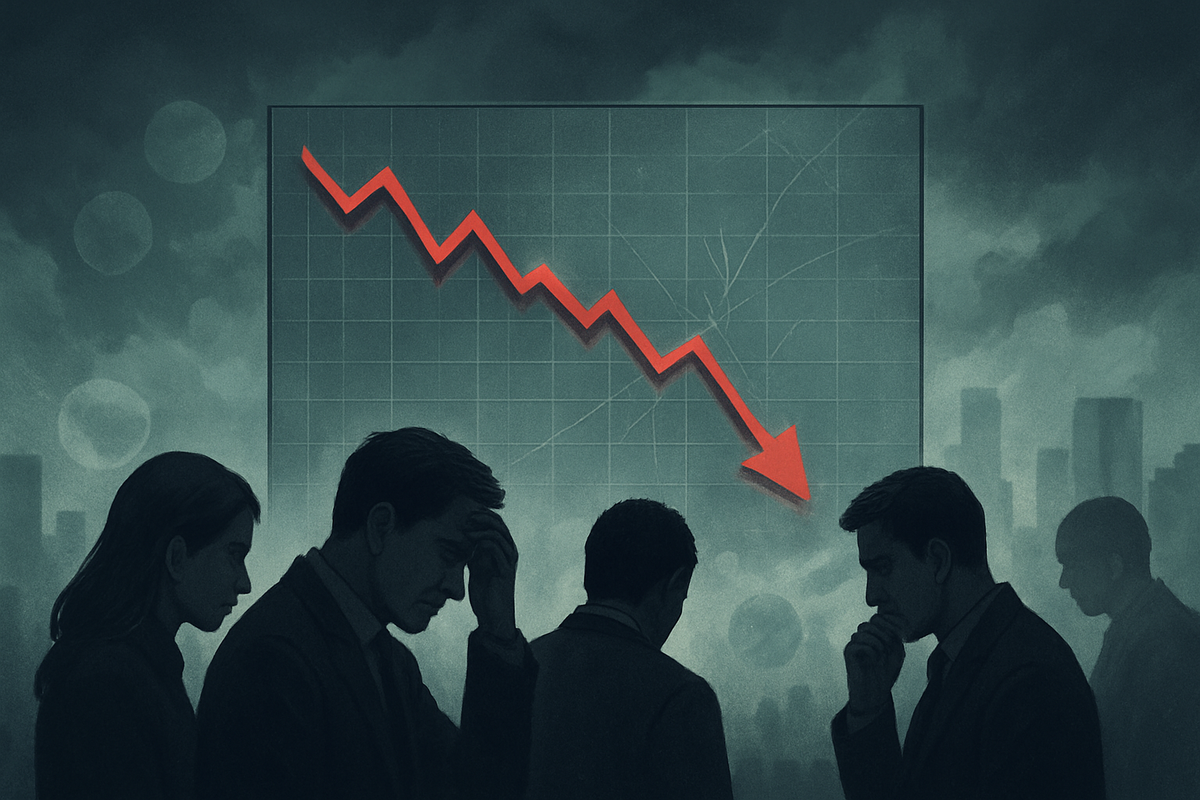
November 14, 2025 – The once-exuberant stock market rally has unequivocally hit a snag, with palpable signs of anxiety now rippling through global financial markets. What was a period of sustained optimism and robust gains has given way to a landscape of heightened volatility and a pervasive sense of caution among investors. This significant shift in market sentiment is prompting a re-evaluation of future outlooks, as market participants grapple with a confluence of economic uncertainties and geopolitical tensions.
The immediate implication is a market that has become increasingly unpredictable, moving away from the steady upward trajectory that characterized much of the preceding months. Investors are no longer blindly chasing growth, but rather meticulously assessing risks and seeking stability in an environment where the path forward appears less clear. This emerging wariness underscores a pivotal moment for the markets, signaling a potential recalibration of expectations and strategies across the investment community.
A Wobbly Ride: Unpacking the Market's Recent Retreat
The recent dent in the stock market rally, particularly evident throughout November 2025, marks a significant departure from the robust performance seen in earlier periods. Major U.S. indices, including the S&P 500, Nasdaq, and Dow Jones Industrial Average, have experienced a "wobbly ride," characterized by notable single-day declines and increased intra-day volatility. This downturn comes despite some indices having reached new highs just a month prior, highlighting the abruptness of the sentiment shift.
A critical factor contributing to this market unease is the significant dialing back of expectations for a Federal Reserve interest rate cut in December. The probability of such a cut has plummeted to approximately 50% by mid-November, a sharp decline from nearly 95% just weeks earlier. This recalibration stems largely from hawkish commentary by Fed officials, who, citing lingering inflation concerns and a resilient labor market, have expressed caution about further monetary easing. This policy uncertainty has left investors questioning the future cost of capital and its impact on corporate earnings.
Adding to the apprehension are growing concerns over stretched valuations, particularly within the technology and artificial intelligence (AI) sectors. These sectors had previously been the primary drivers of the market's gains, leading to fears of an "AI bubble." This has prompted a rotation out of high-valuation tech stocks, with companies like Nvidia (NASDAQ: NVDA), Broadcom (NASDAQ: AVGO), and Alphabet (NASDAQ: GOOGL) experiencing significant declines. Furthermore, a recent prolonged U.S. government shutdown created a "data void," delaying the release of crucial economic indicators and leaving investors "flying blind," thus exacerbating uncertainty.
The shift in sentiment is perhaps best encapsulated by figures like Jim Cramer, who has expressed an "urgent take" on the market's current state. While specific details of his latest commentary would need to be researched, his past pronouncements often reflect prevailing market anxieties, and his "urgent" tone suggests a recognition of the increased risks and the need for investors to exercise heightened caution. Initial market reactions have included a noticeable spike in the CBOE Volatility Index (VIX), often called the market's "fear gauge," and a discernible shift towards safe-haven assets such as gold and silver, signaling increased risk aversion among investors.
Navigating the Shifting Tides: Potential Winners and Losers
The current market recalibration is poised to create a distinct divide between potential winners and losers, as investors adapt their strategies to a more cautious environment. Companies with robust balance sheets, consistent cash flows, and exposure to defensive sectors are likely to fare better, while those heavily reliant on aggressive growth assumptions or high valuations may face continued pressure.
Potential Losers:
- High-Growth Technology Companies: Companies in the technology and AI sectors that have enjoyed significant valuation expansion based on future growth prospects, such as many software-as-a-service (SaaS) providers and emerging AI innovators, are particularly vulnerable. As investors become more risk-averse and interest rate cut expectations diminish, the present value of their future earnings becomes less attractive. Companies like Palantir Technologies (NYSE: PLTR) or Snowflake (NYSE: SNOW), known for their high growth narratives, could see continued multiple compression.
- Interest-Rate-Sensitive Sectors: Real estate investment trusts (REITs) and certain financial institutions that are highly sensitive to interest rate fluctuations may struggle. Higher-for-longer interest rates can increase borrowing costs for real estate developers and homeowners, impacting property values and mortgage demand. Banks with significant exposure to variable-rate loans might also see reduced demand or increased default risks if economic growth slows.
- Highly Leveraged Companies: In an environment of potentially higher interest rates and tighter credit conditions, companies with substantial debt burdens will face increased financing costs, eroding profitability and potentially raising solvency concerns. This could impact firms across various sectors that have relied on cheap debt for expansion.
Potential Winners:
- Defensive Sectors: Consumer staples, utilities, and healthcare companies are traditionally considered defensive. Their products and services remain in demand regardless of economic cycles, making them attractive during periods of uncertainty. Companies like Procter & Gamble (NYSE: PG), Johnson & Johnson (NYSE: JNJ), or Duke Energy (NYSE: DUK) may see increased investor interest due to their stable earnings and dividend payouts.
- Value Stocks: As the market shifts away from growth at any cost, value-oriented companies with strong fundamentals, reasonable valuations, and a history of profitability could see renewed interest. This includes mature industrial companies, certain manufacturing firms, and established consumer brands that have been overlooked during the growth-stock frenzy.
- Commodity Producers: With increased geopolitical risks and a flight to safe-haven assets, commodity producers, particularly those in gold and silver mining, stand to benefit. Companies like Barrick Gold (NYSE: GOLD) or Newmont Corporation (NYSE: NEM) could see their stock prices appreciate as the demand for precious metals rises. Energy companies, such as ExxonMobil (NYSE: XOM) or Chevron (NYSE: CVX), might also see stability if global supply concerns persist.
Broader Implications and Historical Parallels
The current dent in the market rally extends beyond mere price fluctuations, reflecting deeper shifts in economic paradigms and investor psychology. This event fits into broader industry trends marked by a re-evaluation of monetary policy effectiveness, the sustainability of tech-driven growth, and the increasing impact of geopolitical instability on global supply chains and consumer confidence. The market's reaction to the Federal Reserve's hawkish stance underscores the enduring influence of central bank policy, a trend that has dominated financial narratives for over a decade.
The potential ripple effects are substantial. Competitors within richly valued sectors may face increased scrutiny, prompting a focus on profitability over pure growth. Partners in supply chains, particularly those reliant on consumer discretionary spending or technology investments, could experience reduced demand. Regulatory bodies might also intensify their oversight of sectors perceived as overvalued, potentially leading to increased antitrust scrutiny or calls for greater transparency, especially in rapidly evolving areas like AI.
Historically, periods of significant market sentiment shifts often follow prolonged rallies fueled by easy monetary policy or technological exuberance. The dot-com bubble burst of 2000, for instance, serves as a powerful precedent, demonstrating how speculative fervor can lead to unsustainable valuations and subsequent sharp corrections. While the current situation is not a direct parallel, the underlying anxieties—concerns about overvaluation, the impact of interest rates, and the sustainability of high-growth narratives—echo sentiments from past downturns. Similarly, the "taper tantrum" of 2013, when markets reacted sharply to the Fed's hints of reducing quantitative easing, highlights the sensitivity of investors to shifts in central bank communication and policy. These historical events underscore that market corrections, while painful, often serve as necessary resets, allowing for a re-pricing of assets based on more realistic fundamentals.
What Comes Next: Navigating the Path Ahead
The immediate future for the market is likely to be characterized by continued volatility and a heightened sensitivity to economic data and central bank commentary. In the short term, investors should anticipate choppy trading as the market attempts to find a new equilibrium. The upcoming economic reports, particularly those related to inflation and employment, which were delayed due to the government shutdown, will be critical in shaping the Federal Reserve's next moves and, consequently, market direction.
In the long term, this period of recalibration could present both significant challenges and emerging opportunities. Companies may need to execute strategic pivots, prioritizing efficiency, cost control, and sustainable profitability over aggressive expansion. Those with strong balance sheets and diversified revenue streams will be better positioned to weather the storm and potentially acquire distressed assets or gain market share. For investors, this environment could favor a more discerning approach, emphasizing fundamental analysis, dividend-paying stocks, and a balanced portfolio allocation. Opportunities may emerge in undervalued sectors or companies that demonstrate resilience and adaptability in the face of economic headwinds.
Potential scenarios range from a "soft landing," where inflation gradually subsides without triggering a severe recession, to a more pronounced economic downturn if interest rates remain elevated for too long or geopolitical tensions escalate further. A key outcome will be a likely moderation of market returns compared to the robust gains of the recent past, necessitating a more patient and strategic investment approach. Companies that can innovate efficiently, manage debt prudently, and demonstrate pricing power will be best equipped to thrive in this evolving landscape.
Comprehensive Wrap-up: A New Era of Prudence
The recent dent in the stock market rally signifies more than just a temporary setback; it heralds a fundamental shift in market dynamics and investor psychology. The key takeaways from this period of emerging anxiety include the profound impact of central bank policy on market sentiment, the inherent risks associated with stretched valuations in high-growth sectors, and the increasing influence of geopolitical factors on economic stability. The market's move away from unbridled optimism towards a more cautious and discerning approach underscores a maturing phase in the current economic cycle.
Moving forward, the market is expected to operate in an environment where prudence and fundamental strength will be highly rewarded. The era of "easy money" and rapid, speculative gains appears to be waning, giving way to a landscape where companies must demonstrate tangible value and sustainable growth. Investors should anticipate continued scrutiny of corporate earnings, balance sheets, and management guidance, with a premium placed on resilience and adaptability.
The lasting impact of this market recalibration will likely be a more disciplined investment community, less prone to speculative bubbles and more focused on long-term value creation. Investors should closely watch for shifts in Federal Reserve rhetoric, the trajectory of inflation and employment data, and any escalation or de-escalation of geopolitical tensions. Monitoring corporate earnings reports for signs of slowing growth or margin compression, particularly in previously high-flying sectors, will also be crucial in the coming months. This period demands a thoughtful and strategic approach, emphasizing risk management and a deep understanding of underlying business fundamentals.
This content is intended for informational purposes only and is not financial advice





